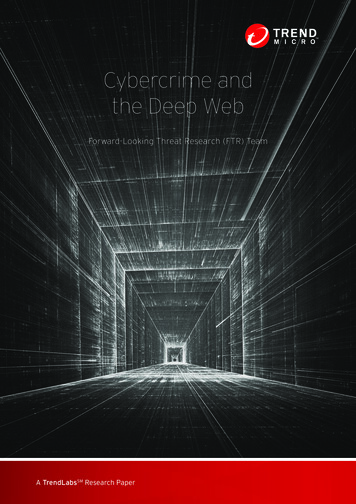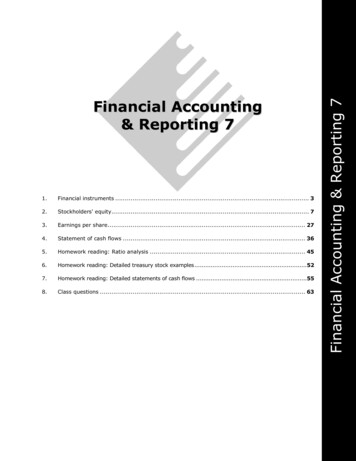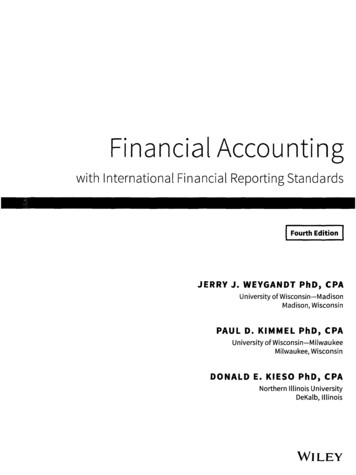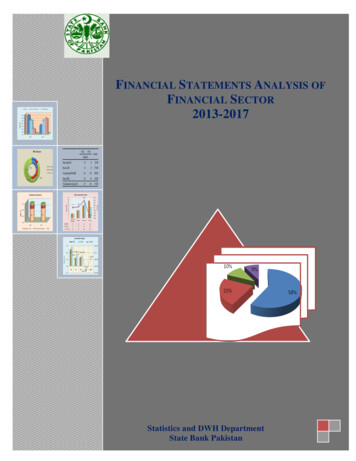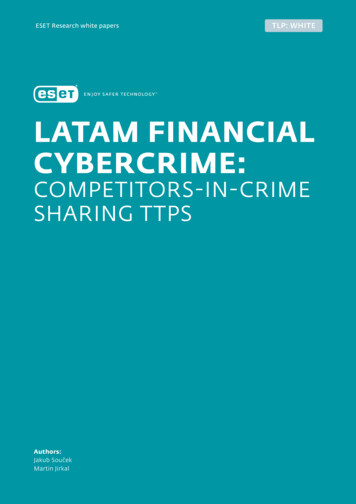
Transcription
ESET Research white papersTLP: WHITELATAM FINANCIALCYBERCRIME:COMPETITORS-IN-CRIMESHARING TTPSAuthors:Jakub SoučekMartin Jirkal
1LATAM financial cybercrime: Competitors-in-crime sharing TTPsTLP: WHITECONTENTSABSTRACT .2INTRODUCTION .2IMPLEMENTATION .3Core of a typical Latin American banking trojan’s implementation . 3Implementation detail similarities . 4String encryption and obfuscation . 4Common enemy: Protection software .Binary obfuscation .DISTRIBUTION .4.5.5Typical Latin American banking trojan distribution chains .5. 6The first link in the chain . 6Script obfuscation .7Targeted countries .7EXECUTION .Sharing the chains .Method 1: Direct execution .7. 8Method 2: Using the AutoIt interpreter . 8Method 3: DLL side-loading . 8.Method 4: DLL side-loading combined with injector .9Legitimate applications being abused .9FAKE POP-UP WINDOWS .MITTRE ATT&CK techniques .CONCLUSION .REFERENCES .APPENDIX A .APPENDIX B .APPENDIX C . 12. 11. 11.10. 13.13. 14Example 1 . 14Example 2 . 14Example 3 . 15Example 4 . 15APPENDIX D .Authors:Jakub SoučekMartin JirkalSeptember 2020. 16
2LATAM financial cybercrime: Competitors-in-crime sharing TTPsTLP: WHITEABSTRACTA significant portion of crimeware in Latin America is dominated by banking trojans. Due to manycommon characteristics, these banking trojans are often treated as one. Our ongoing research clearlyshows that is not the case and that at least 11 distinct malware families reside among them. Moreimportantly, they are constantly evolving and incorporating new Tactics, Techniques and Procedures(TTPs).Over the course of our research, one thing has become clear: the operators of these banking trojansappear to be in contact with one another. We spotted this first when examining algorithms used forstring encryption. Most Latin American banking trojans use very simple, custom encryption schemesthat are generally unknown in the broader programming community, and yet we see the samealgorithm being used in six different families.These common features do not end with the binaries’ contents. By examining the distribution chains(usually a combination of several stages written in various scripting languages), we find usage of thesame obfuscation methods or packers applied to different scripts.During our research, we have encountered some major milestones – changes that affected basicallyall the families we have identified. We have seen the vast majority of those families transitioningfrom VMProtect to Themida; both powerful binary obfuscation tools. Similarly, many of them globallyswitched their initial download method to using Windows Installer (MSI) over the period of just a fewmonths.Finally, some TTPs seem to stay strongly rooted deep inside the region. These include heavily utilizingZIP archives and using DLL side-loading as the favored execution method.Even though sharing knowledge between cybercriminals is not unusual, seeing so many examples ofit in region-specific malware families with the same focus caught our attention. Our presentationwill cover all the common characteristics we have discovered and include a timeline illustrating theevolution of these banking trojans. We will draw conclusions about which families are most closelyinterlinked and how the modus operandi of Latin American banking trojans is different from bankingtrojans in the rest of the world.INTRODUCTIONDominating crimeware in the region, Latin American banking trojans share so many characteristicsthat they are conventionally treated as one single malware family. Our ongoing research clearly showsotherwise, identifying at least 11 distinct and concurrently active families: Amavaldo (1), Casbaneiro (2),Grandoreiro (3), Guildma (4), Mispadu (5), Mekotio (6), Zumanek (7), Krachulka, Lokorrito, Numandoand Vadokrist (in prep). IoCs of all these families are on ESET’s malware IoC GitHub repository (8)and detailed descriptions, including MITRE ATT&CK tables, of several are available in the blogpostsreferenced above.Given that we consider these to be different malware families, it may seem surprising they have somuch in common. We believe the reason is that the authors of these banking trojans are in touch witheach other, sharing TTPs. In this paper, which would not have been possible without the invaluablecontributions of our colleagues in the ESET Prague team, particularly Juraj Horňák and Roman Šíma, wewill dissect the most notable similarities that lead us to this conclusion.
3LATAM financial cybercrime: Competitors-in-crime sharing TTPsTLP: WHITEIMPLEMENTATIONThe first area we will focus on is the implementation details of these families. Besides the most notableone – that they are all written in Delphi – the binaries are so similar in their core functionality that italmost seems like they were built from one set of blueprints.Core of a typical Latin American banking trojan’s implementationThe typical Latin American banking trojan first collects information about the victim’s machine. Thisusually consists of the computer name, username, some unique identifier and sometimes indicators ofwhether security or banking protection software is installed. The malware then sends this informationto a URL distinct from the C&C server (based on debug information we were able to gather from somebinaries, the authors refer to this step as Registro, which translates to Registration).Once the Registration phase is complete, the banking trojan periodically checks the titles of activewindows. If a title matches any of the names hardcoded in the binary, the trojan launches its attack. Theattack consists of displaying a fake pop-up window crafted specifically for that targeted institution. Thiswindow is controlled by an underlying Delphi form and typically tries to persuade the victim to divulgesensitive information. Additionally, the malware usually tries to make it as hard as possible for thepotential victim to get rid of the window by: blocking input anywhere else keeping the window always on top disabling hotkeys disabling Task Manager blocking mouse manipulationThe whole process is illustrated by the flowchart in Figure 1.Figure 1 // Flowchart of the core functionality of a typical Latin American banking trojanAll of the 11 distinct families we have identified follow this implementation blueprint. We have also seenall of these families being active simultaneously and, while they follow the same logic, we are certainthat they are implemented independently.The implication here is obvious – the authors of these families cooperate. We believe it to be nearlyimpossible for 11 malware authors to have such specific common ideas without communicating betweenthemselves. And we also don’t believe there is one group of malware authors willingly maintaining 11different pieces of malware with exactly the same logic and goal.
4LATAM financial cybercrime: Competitors-in-crime sharing TTPsTLP: WHITEImplementation detail similaritiesEven though following the same blueprint is the most significant similarity, it is not the only one.Besides that, Latin American banking trojans share several implementation techniques as well. Forexample, Amavaldo, Casbaneiro, Mekotio, Mispadu and Vadokrist all base their communicationprotocols on the custom, third-party remote-control component Delphi Remote Access PC (9).Casbaneiro and Vadokrist contain identical pieces of code for creating and managing a string table. Thevast majority of the malware families rely on the Magnification.dll when taking screenshots - a DLLimplementing the Windows Magnification API and rarely seen used in other malware.Most of the families also enable the Desktop Window Manager (10) and disable Google Chromehardware acceleration by changing its %LOCALAPPDATA%\Google\Chrome\User Data\Local Stateconfiguration file. We strongly believe that this is an attempt to avoid graphics issues when displayingthe fake pop-up windows.String encryption and obfuscationMost of the Latin American banking trojans use custom encryption schemes, which could suggest thatthe authors come up with the algorithms by themselves. However, that is not the case, as one suchencryption scheme (11) is used in six distinct families (Casbaneiro, Grandoreiro, Guildma, Numando,Mekotio and Zumanek) and to the best of our knowledge has not been seen used in other malware.Other encryption schemes are shared as well, although not so significantly.Besides encryption, the only two commonly seen string obfuscation techniques are using a string tableor splitting the string into multiple parts and then using string concatenation to join them when needed(see Figure 2). The latter method usually protects the string decryption key.Figure 2 // Methods of string manipulation used in Latin American bankingtrojans – string concatenation (left) and string table (right)Common enemy: Protection softwareIn Latin America, there are two common security products related to banking institutions. The first oneis Trusteer, developed by IBM, and it provides authentication and protection against fraud. The secondone is called Warsaw, or GBPlugin, and is developed by GAS Tecnologia1. Quite a few Latin Americanbanks (12) require the latter product to be installed on their users’ devices, to provide secure access toonline banking services.1GAS stands for Global Antifraud Solution.
5LATAM financial cybercrime: Competitors-in-crime sharing TTPsTLP: WHITENaturally, Latin American banking trojans have to deal with these products in some way. Some justcheck whether they are installed and report that information in the Registration phase or quit. Some tryto protect themselves, mainly by hooking Windows APIs to prevent those products from being injected.The rest go even further and try to kill those products. We have seen this done by renaming file system paths blocking the products at the firewall level tampering with the files’ ACLs to prevent them from running using a dedicated driver to remove crucial filesBinary obfuscationAuthors of these banking trojans are fond of using VMProtect, a powerful binary obfuscation tool. In2017, many of the banking trojans we saw relied on this tool. However, its popularity started to drop in2018 and today we rarely see it anymore, although some families still use it.Those that do not use VMProtect seem to have replaced it with one of its competitors – Themida. Thepopularity of this tool seems to be increasing and more families are experimenting with it.DISTRIBUTIONEven though implementation details share quite a few similarities, it does not end there. In this section,we will focus on similarities in distribution chains.Typical Latin American banking trojan distribution chainsThe initial attack vector is typically spammed link or attachment or malvertising (as in the case ofMispadu, which we describe in detail in our blog post (5)). The attack starts with one malicious file thatis a downloader written in either Delphi or a scripting language, or occasionally an Office documentwith an embedded malicious macro. For the attack to be successful, the potential victim must downloadand execute the attachment or file (often inside a ZIP archive).When executed, this file can lead to subsequent stages that typically are designed only to download thenext stage until the final stage is reached. Delphi downloaders typically consist of a single stage, whilescript downloaders tend to use multiple stages written in various scripting languages.In the vast majority of these families, the logic in each variant’s final stage is almost identical. It typicallychecks for a marker first. A marker is a unique object, typically a file in a specific directory or a Registrykey or value, created only by that stage to see whether the malware has already compromised thismachine. If not found, it continues by downloading a ZIP archive.The ZIP archive is something very typical for the distribution chains of Latin American bankingtrojans. We have observed only a negligible number of chains that did not utilize one. An interesting,atypical example is the Mispadu family’s final stage that, even though it downloads the componentsindependently, wraps each one in a separate ZIP archive.When the final stage downloads the archive, it follows by: extracting its contents installing the malware to the specified location executing it sometimes also setting up persistence (either by using a Run key or LNK file)The whole process is illustrated by the flowchart in Figure 3.
6LATAM financial cybercrime: Competitors-in-crime sharing TTPsTLP: WHITEFigure 3 // Flowchart of a typical distribution chain used by Latin American banking trojansEvery Latin American banking trojan’s distribution chain more or less follows this logic. We have seencomponents of this chain and its stages implemented in Delphi, VBScript, JavaScript, PowerShell, AutoItand batch script. Despite the number of different implementations, the logic remains the same for themajority of the families we have analyzed.It might appear that some threat actor is implementing these chains and providing distribution for thebanking trojan operators. However, if that were the case, this actor would have to implement severaldistinct chains for each family. Similar as they might be, each family has its set of distribution chains ittends to use. Additionally, the chain is very tightly connected to how the banking trojan is executed.We have never observed any of these chains distribute any
FAKE POP-UP WINDOWS 10 MITTRE ATT&CK techniques 11 CONCLUSION 11 . In Latin America, there are two common security products related to banking institutions The first one is
